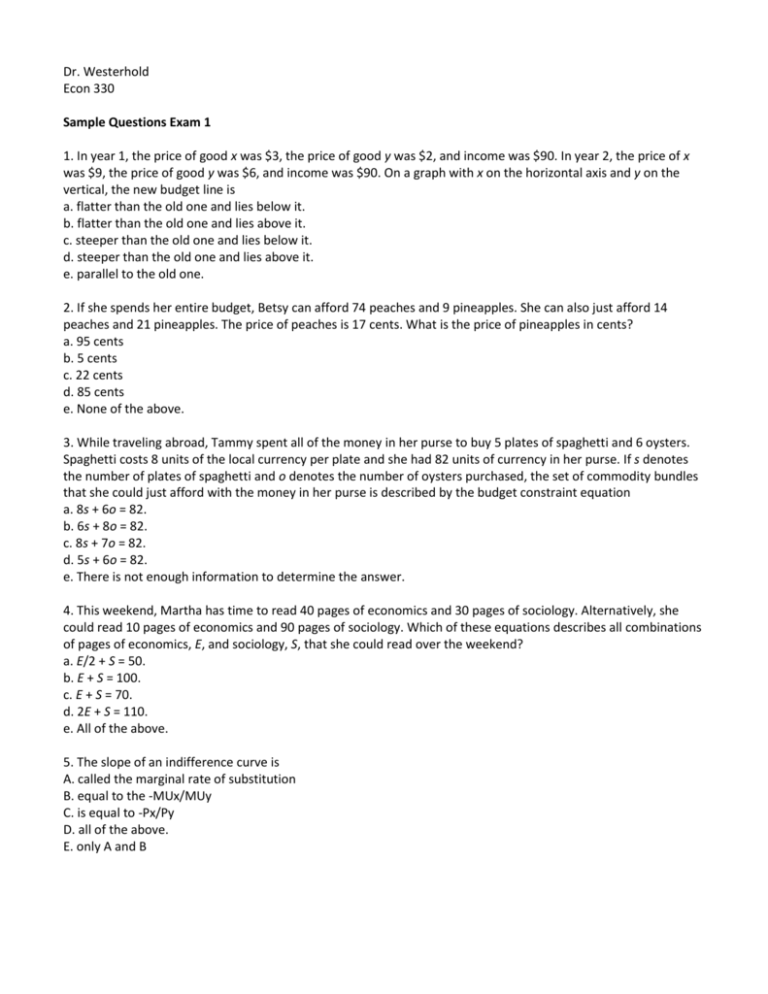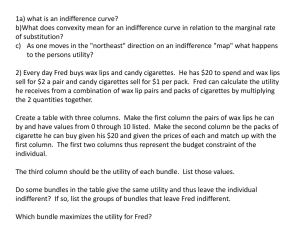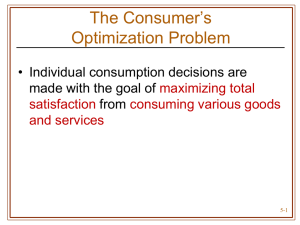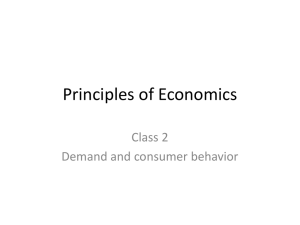Econ 330
advertisement

Dr. Westerhold Econ 330 Sample Questions Exam 1 1. In year 1, the price of good x was $3, the price of good y was $2, and income was $90. In year 2, the price of x was $9, the price of good y was $6, and income was $90. On a graph with x on the horizontal axis and y on the vertical, the new budget line is a. flatter than the old one and lies below it. b. flatter than the old one and lies above it. c. steeper than the old one and lies below it. d. steeper than the old one and lies above it. e. parallel to the old one. 2. If she spends her entire budget, Betsy can afford 74 peaches and 9 pineapples. She can also just afford 14 peaches and 21 pineapples. The price of peaches is 17 cents. What is the price of pineapples in cents? a. 95 cents b. 5 cents c. 22 cents d. 85 cents e. None of the above. 3. While traveling abroad, Tammy spent all of the money in her purse to buy 5 plates of spaghetti and 6 oysters. Spaghetti costs 8 units of the local currency per plate and she had 82 units of currency in her purse. If s denotes the number of plates of spaghetti and o denotes the number of oysters purchased, the set of commodity bundles that she could just afford with the money in her purse is described by the budget constraint equation a. 8s + 6o = 82. b. 6s + 8o = 82. c. 8s + 7o = 82. d. 5s + 6o = 82. e. There is not enough information to determine the answer. 4. This weekend, Martha has time to read 40 pages of economics and 30 pages of sociology. Alternatively, she could read 10 pages of economics and 90 pages of sociology. Which of these equations describes all combinations of pages of economics, E, and sociology, S, that she could read over the weekend? a. E/2 + S = 50. b. E + S = 100. c. E + S = 70. d. 2E + S = 110. e. All of the above. 5. The slope of an indifference curve is A. called the marginal rate of substitution B. equal to the -MUx/MUy C. is equal to -Px/Py D. all of the above. E. only A and B 6. Suppose there are two goods, X and Y, with X measured on the horizontal axis and Y on the vertical axis. Which of the following statements about a budget line relating the two goods is incorrect? A. the budget line shows all the combinations of X and Y a consumer can buy, given the income and prices assumed. B. the slope of the budget line is -Py/Px. C. the slope of the budget line reflects the tradeoff of one good for another. D. we can afford any bundle inside the budget line. 7. A set of indifference curves showing that the consumer is indifferent between A and B, and market baskets A and C, but that market basket C is preferred to B must be A. horizontal B. positively sloped. C. parallel. D. intersecting. 8. A decline in income is shown by A. a slowdown in the rate of inflation. B. a parallel shift in the budget line toward the origin. C. a rotation of the budget line so it intersects the vertical axis closer to the origin. D. a change in the relative price ratio. 9. Pencils sell for 10 cents and pens sell for 50 cents. Suppose Jack, whose preferences satisfy all of the usual assumptions, buys 5 pens and one pencil each semester. With this consumption bundle his MRS of pencils for pens is 3 (MU pencils/MU pens). Which of the following is true? A. Jack could increase his utility by buying more pens and less pencils. B. Jack could increase his utility by buying less pens and more pencils C. Jack could increase his utility by buying more pens and more pencils D. Jack could increase his utility by buying less pens and less pencils E. Jack is already maximizing utility. 10. Steven’s indifference curves are circles, all of which are centered at (15, 13). Of any two indifference circles, he would rather be on the inner one than the outer one. a. Steven prefers (19, 22) to (13, 7). b. Steven prefers (13, 22) to (13, 7). c. Steven prefers (12, 10) to (22, 18). d. Steven’s preferences are not complete. e. More than one of the above statements are true. 11. If we graph Mary Granola’s indifference curves with avocados on the horizontal axis and grapefruits on the vertical axis, then whenever she has more grapefruits than avocados, the slope of her indifference curve is-2. Whenever she has more avocados than grapefruits, the slope is -1/2. Mary would be indifferent between a bundle with 14 avocados and 20 grapefruits and another bundle that has 26 avocados and a. 11 grapefruits. b. 18 grapefruits. c. 6 grapefruits. d. 16 grapefruits. e. 13.5 grapefruits. 12. Angela has preferences represented by the utility function U(x, y) = 2x + 2y. She consumes 10 units of good x and 6 units of good y. If her consumption of good x is lowered to 4, how many units of y must she have in order to be exactly as well off as before? a. 14 b. 13 c. 12 d. 15 e. None of the above. 13. Charlie has the utility function U(xA, xB) = xAxB. His indifference curve passing through 32 apples and 8 bananas will also pass through the point where he consumes 4 apples and a. 16 bananas. b. 32 bananas. c. 68 bananas. d. 72 bananas. e. 64 bananas. 14. Graph the following scenario I=600 Price of Health Care=$50 per unit Composite Good= $1 per unit A) Draw the BL. B) Draw in BL2 where a health care grant of $200 is given to the consumer and this money can only be used for health care. C) Draw in BL3 indicating the BL if the $200 is given as cash instead. D) Draw in an indifference curve indicating the consumer prefers the cash grant (Think about the placement of the indifference curve now that we’ve done indifference curves). 15. Assume Jane’s utility function is given by: U=4X.5Y.5 Assume the Px=25 and Py=20 and m=750. Calculate the optimal quantities of X and Y and determine the total level of utility received. Graph your final answer. 16. Jane lives in a dorm that offers soda (S) and chips (C) in the vending machines. Her utility function is U=3SC. If the price of soda is $.50 and the price of chips is $.25 and she has $5 to spend each week on vending machine items, how many Sodas and Chips will she buy. What is her total level of utility? 17. Consumers in Georgia pay twice as much for avocados as they do for peaches. However, peaches and avocados are equally priced in California. If consumers in both states maximize utility will the MRS of peaches for avocados be the same for consumers in both states? If not, which will be higher? Calculate the MRS for both and compare. 18. Peter consumes no commodities other than Miller Lite and Bud Light. His annual budget for these two commodities is described by the equation 5x + 30y =300, where x is sixpacks of Miller Lite and y is cases of Bud Light. Peter considers 2 cases of Bud Light to be perfect substitutes for 6 sixpacks of Miller Lite. a. He will consume 60 sixpacks of Miller Lite per year. b. He will consume 10 cases of Bud Light per year. c. He will consume 14 cases of Bud Light per year. d. He will consume 12 sixpacks of Miller Lite per year. e. He is indifferent between any two bundles that use up his entire income 19. Coke and Pepsi are perfect substitutes for Mr. Drinker and the slope of his indifference curves is -1. One day he bought 20 cans of Coke and 20 cans of Pepsi. (The cans of both drinks are the same size.) a. Coke is less expensive than Pepsi. b. Coke is more expensive than Pepsi. c. Coke and Pepsi cost the same. d. Mr. Drinker prefers Pepsi to Coke. e. None of the above. 20. Charlie’s utility function is U(xA, xB) = xAxB. If Charlie’s income is $40, the price of apples is $4, and the price of bananas is $2, how many apples are there in the best bundle that Charlie can afford? a. 10 b. 8 c. 12 d. 9 e. 5 21. Draw the following utility curves for Good X. Always assume that Good Y is an economic good. Good X is an economic bad. Good X is an economic neuter. Good X and Good Y are perfect substitutes such that the MRS=5. Good X and Good Y are perfect complements in a fixed ratio of 3X to 2Y. 22. Draw the BL for the following price schedule. I=100 Py=1 For 1st ten units: Px=5 For 2nd ten units: Px=3 For 3rd ten units: Px=2 At each interval calculate the slope (show on graph) and determine the amount of Y that can be consumed at each level. 23. Deriving demand and price offer curves (Building off of work already done in question #15) Suppose Px=25; Py=20; m=750 and U=4X.5Y.5 ; determine the optimal bundle for the consumer. Further assume that the price of X decreases to $15. Now determine the new consumer equilibrium and derive the demand and price offer curve for Good x. Answers to Sample Packet 2— (If you believe that an answer could be wrong, please let me know. I will make post necessary corrections on the website) 1. 2. 3. 4. 5. 6. 7. 8. 9. 10. 11. 12. 13. 14. 15. 16. 17. 18. 19. 20. 21. 22. 23. E D C D E B D B B C A C E BL1 (xintercept 12; y intercept 600). BL2 (x intercept 16; y intercept 600; kink at 4); BL3 (x intercept 16; y intercept 800). Utility curve should be tangent at Health care at less than 4 units. BL intercepts (30, 37.5) equilibrium point is x=15; y=18.75; u=67 soda=5; chips=10; u=150 if Peaches are on the horizontal axis then Georgia consumers will have an MRS=1/2 and California consumers will have MRS=1. If peaches are on the vertical axis then Georgia consumers will have MRS=2 and California consumers will have MRS=1 A C E if X is bad then upward sloping U curving toward Y axis. If X is neuter then horizontal U1. If X and Y perfect substitutes with MRS=5 then would substitute 5 units of Y for 1 x so 5Y and 1X on same, linear U. If X and Y are perfect complements then U are right angles at 3X, 2Y. BL gets flatter as move out X axis. Y values at each interval should be: at X=10; Y=50; at X=20, Y=20; at X=30 Y=0. At original prices consumer equilibrium is such that x=15; y=18.75; u=67; new BL intercepts will be (50, 37.5); new equilibrium position will be (25, 18.75) and new u=86.6. Deriving the demand should create two points (15, $25) and (25, $15) showing m=750 and py=20. (Note: the numbers here are coincidental and not indicative of a common pattern!)









